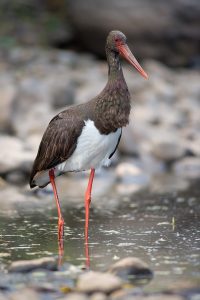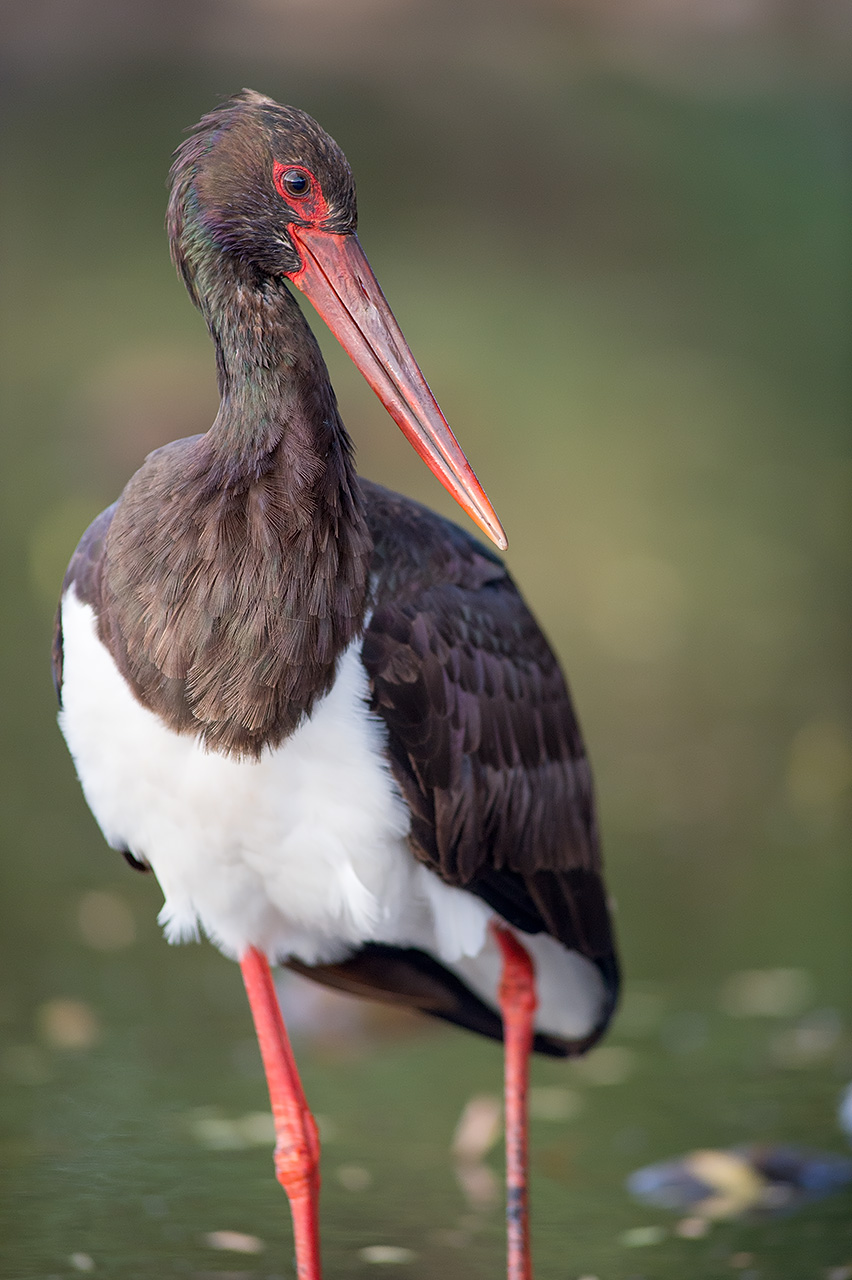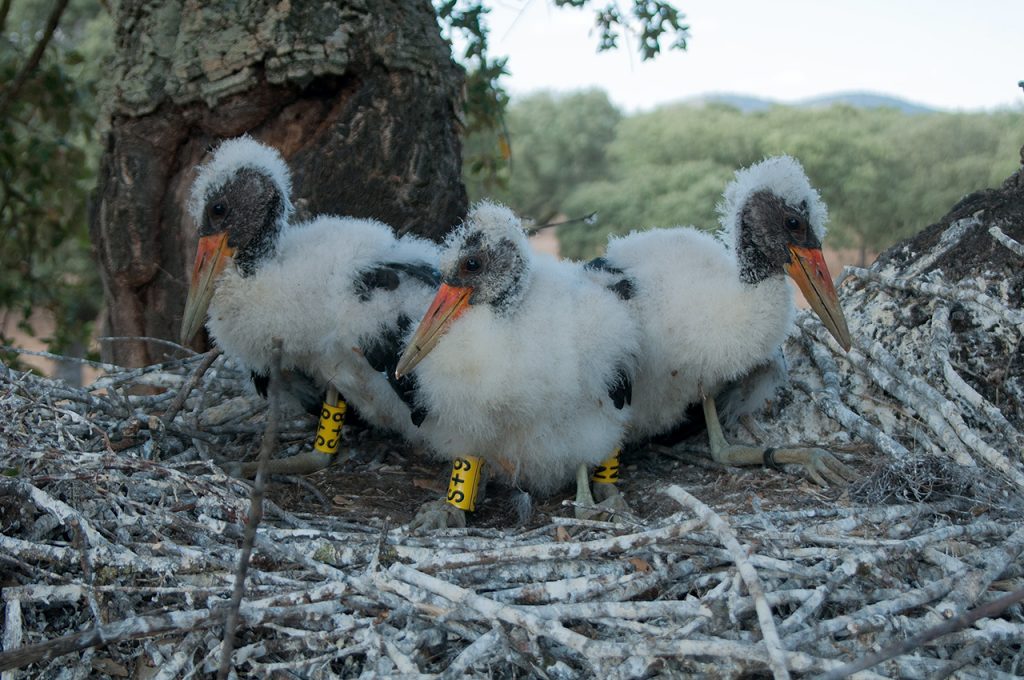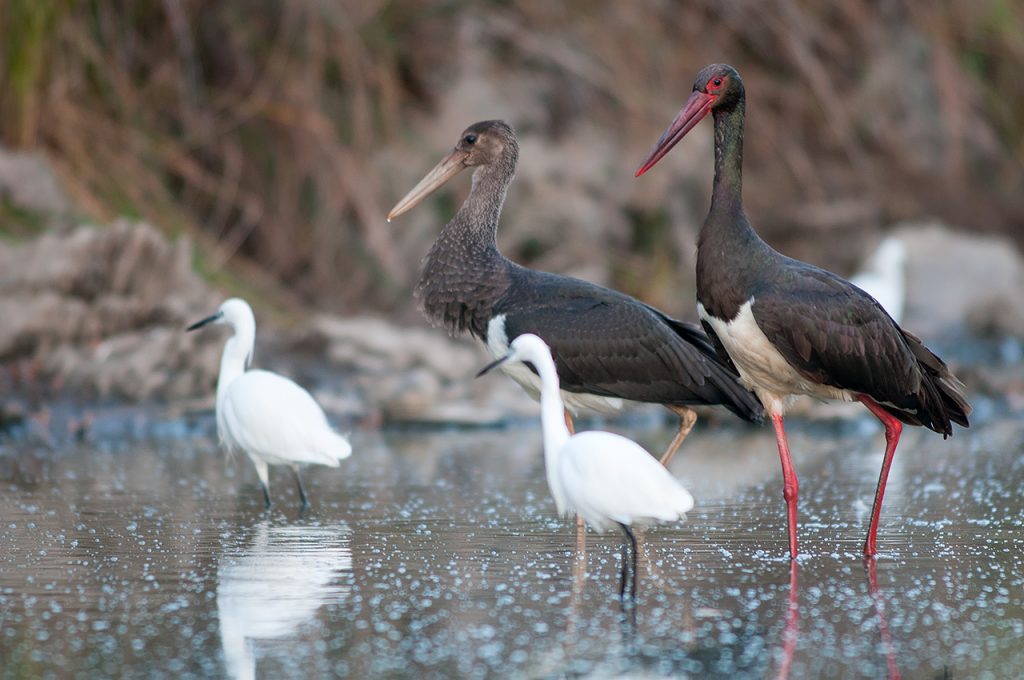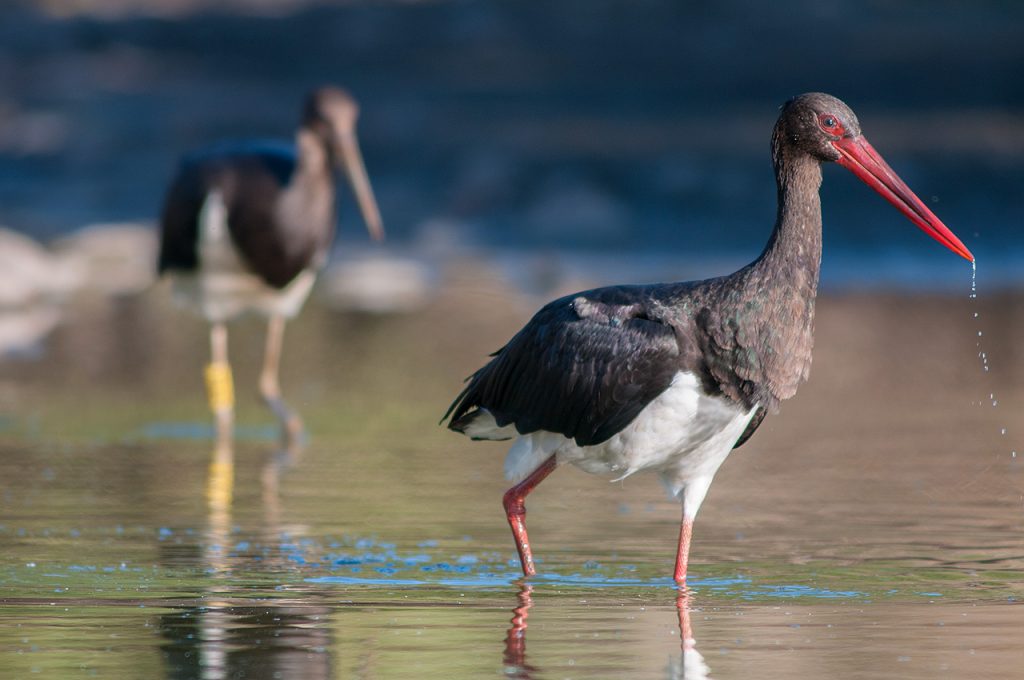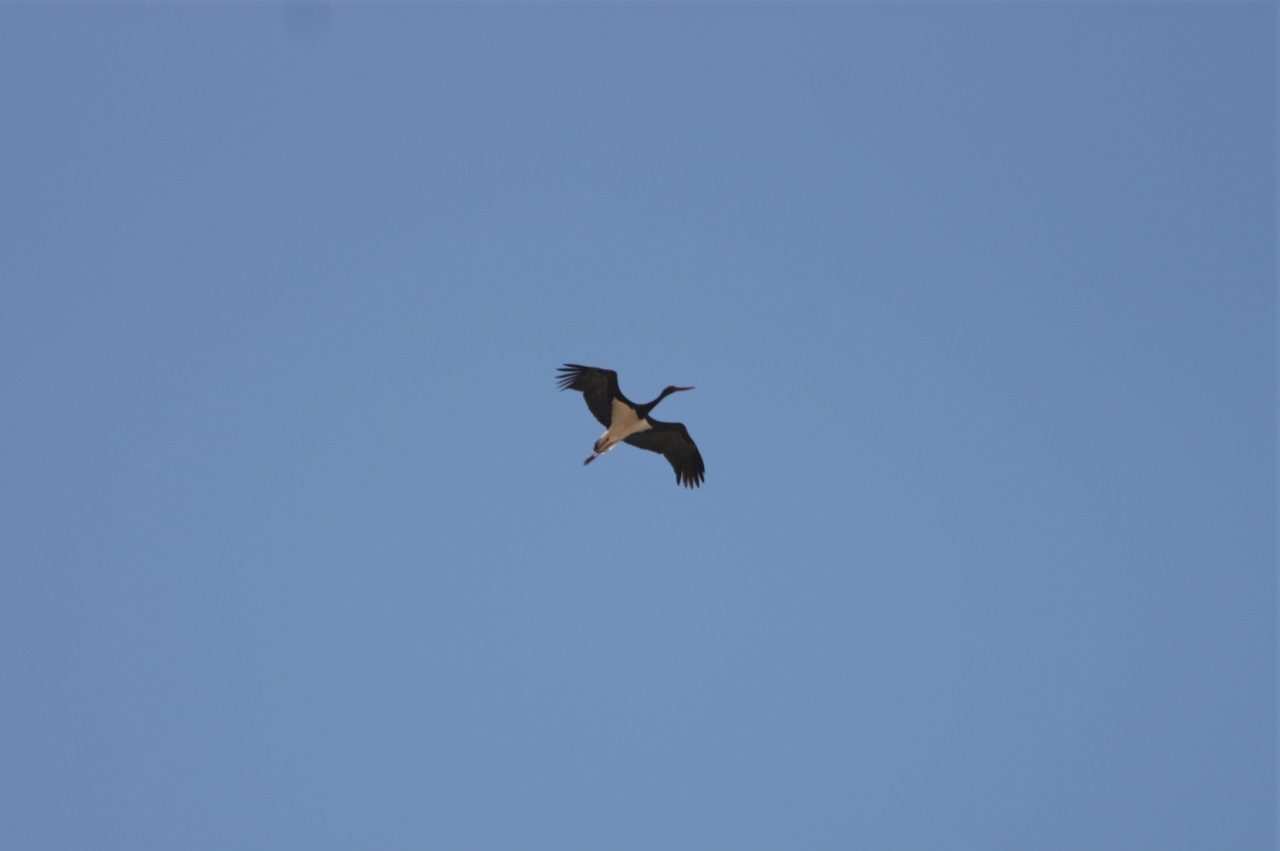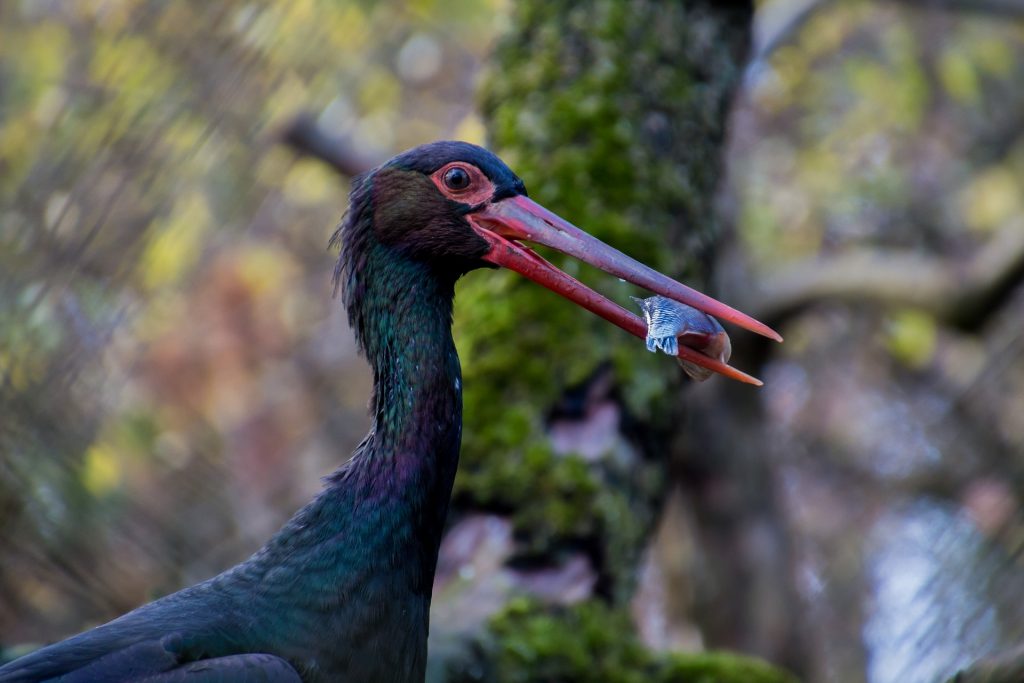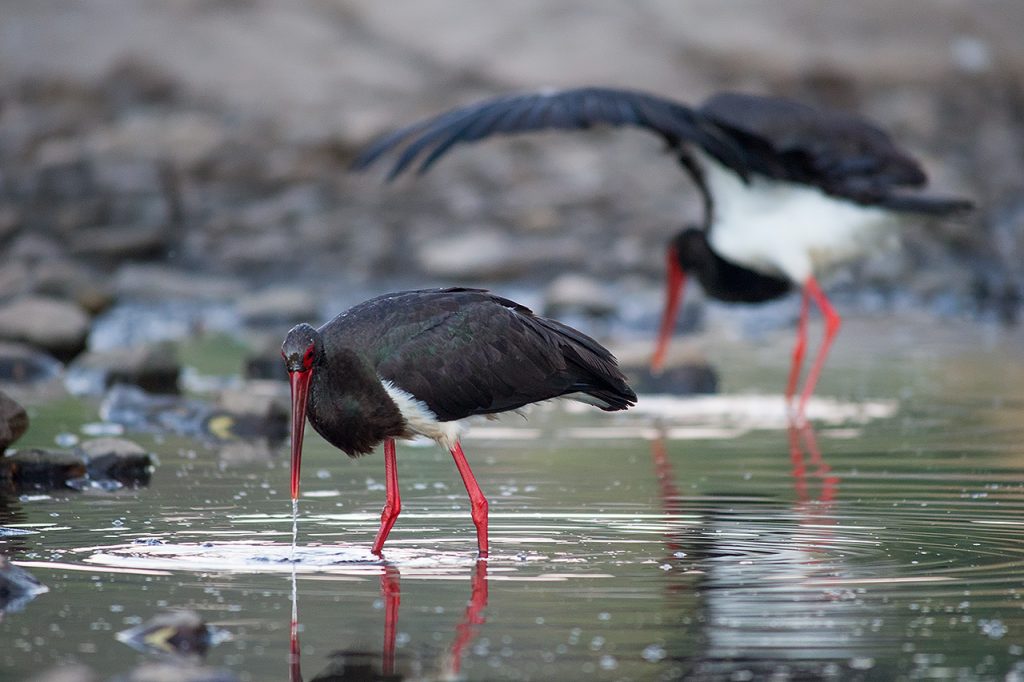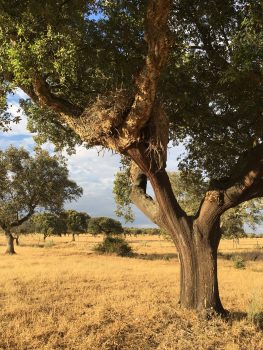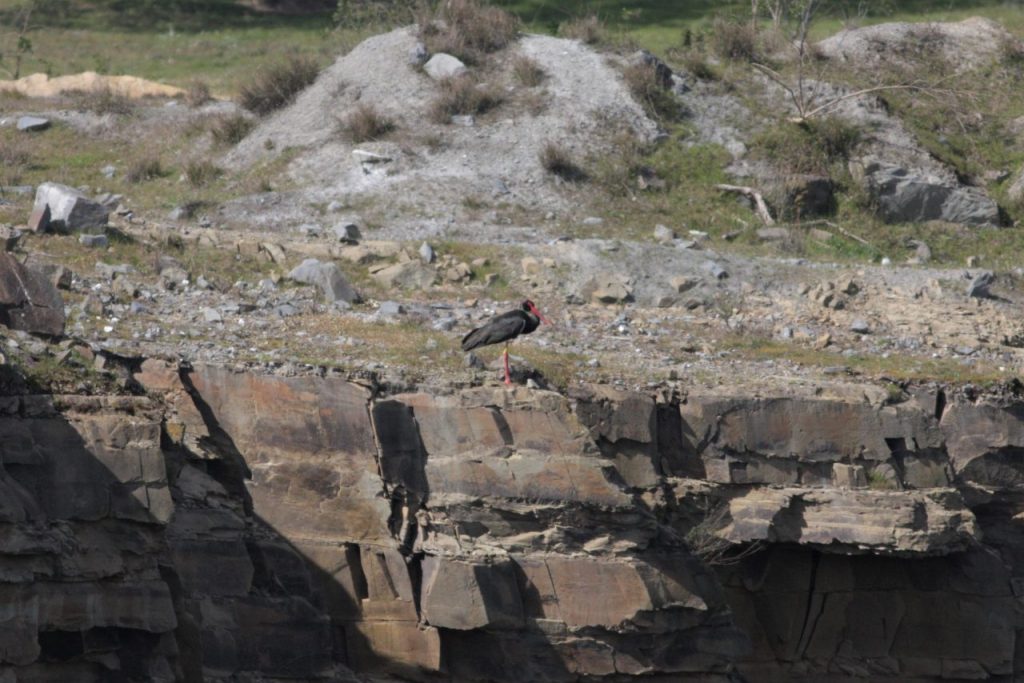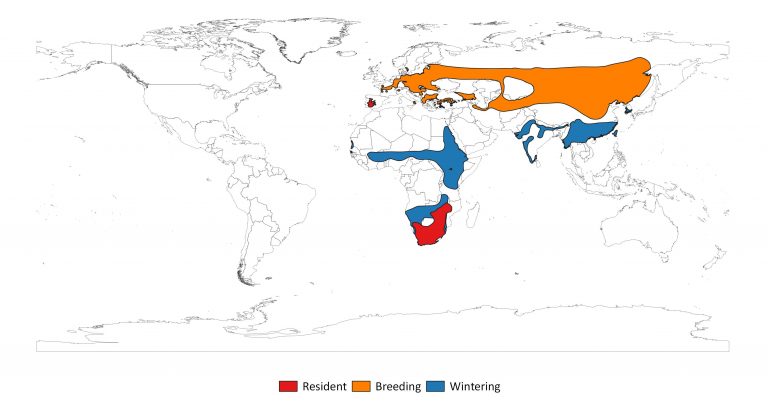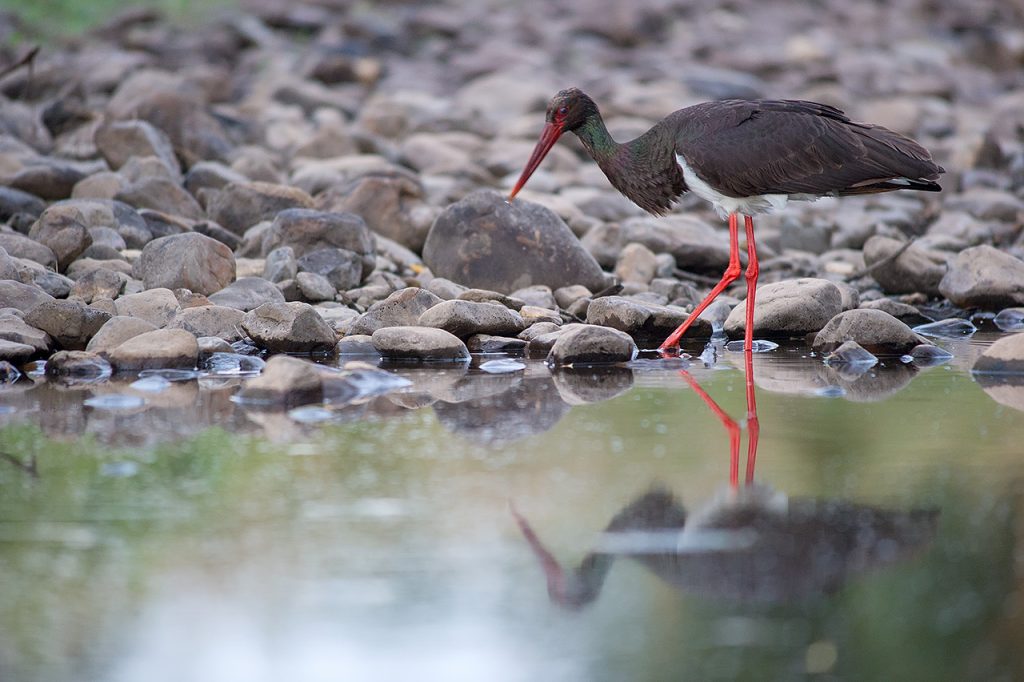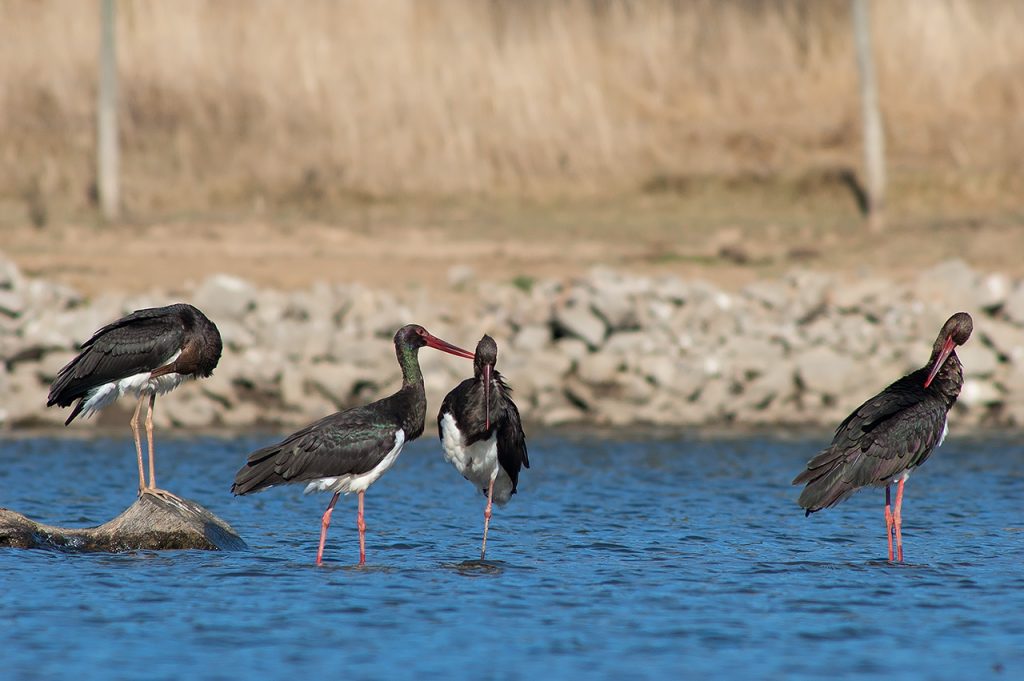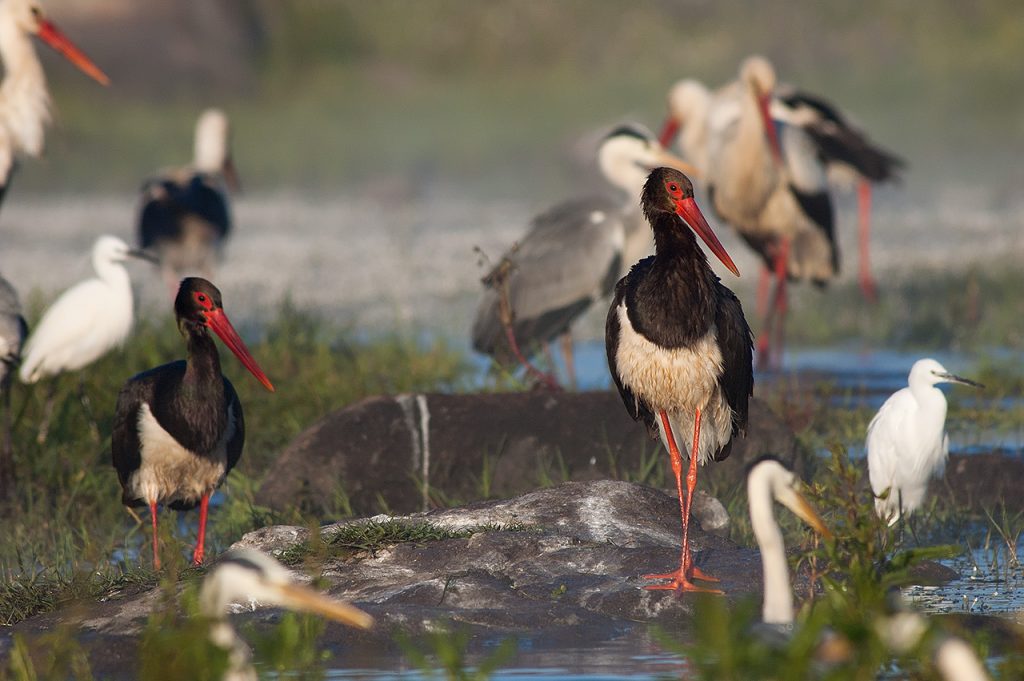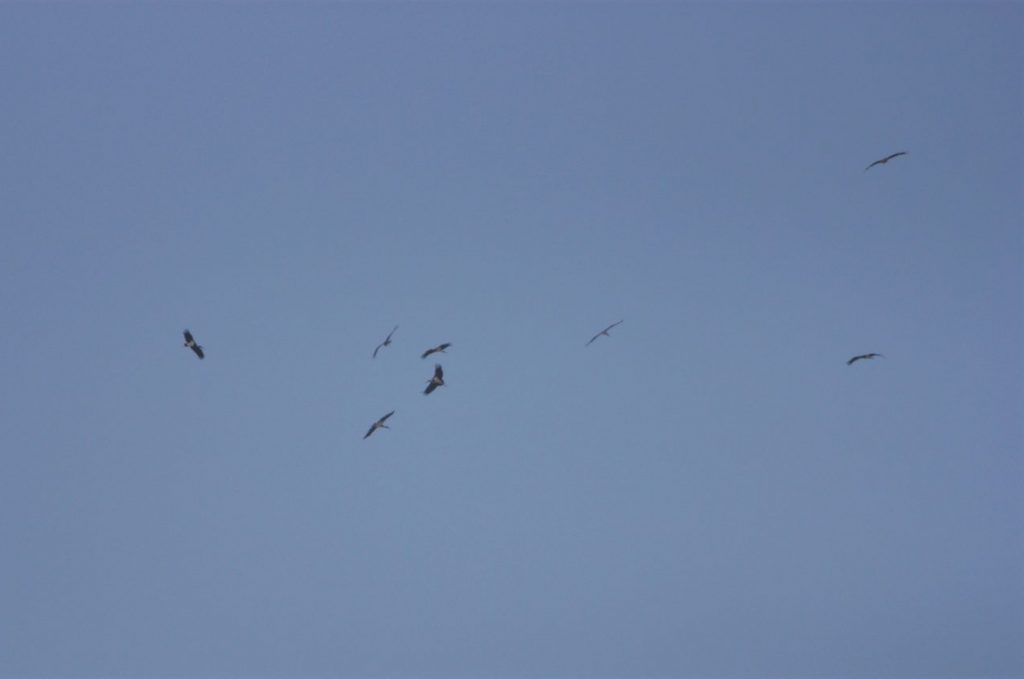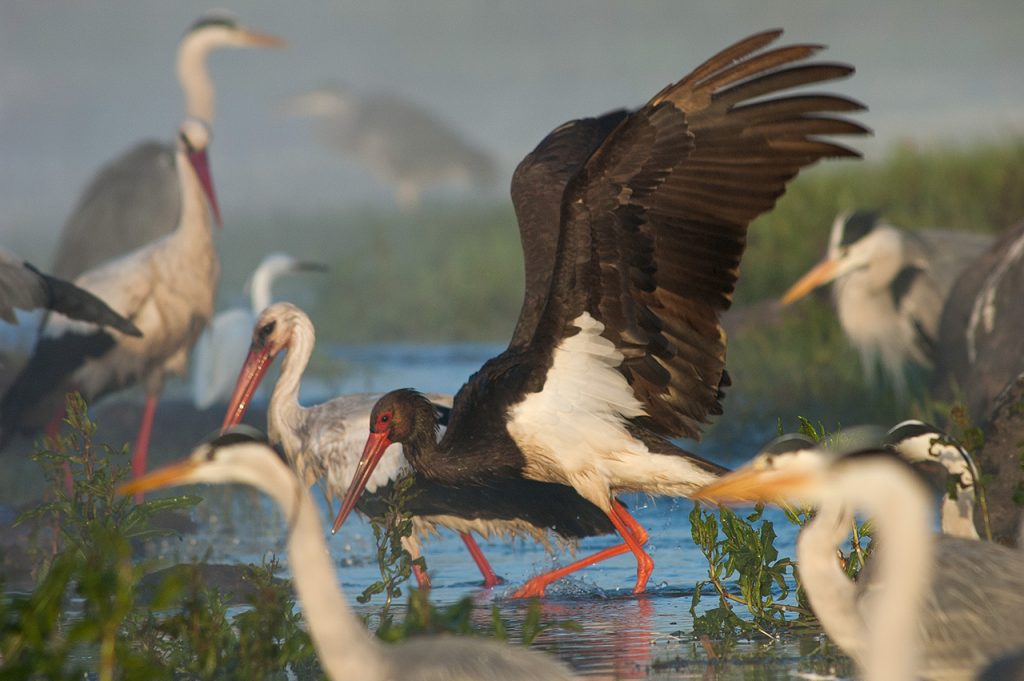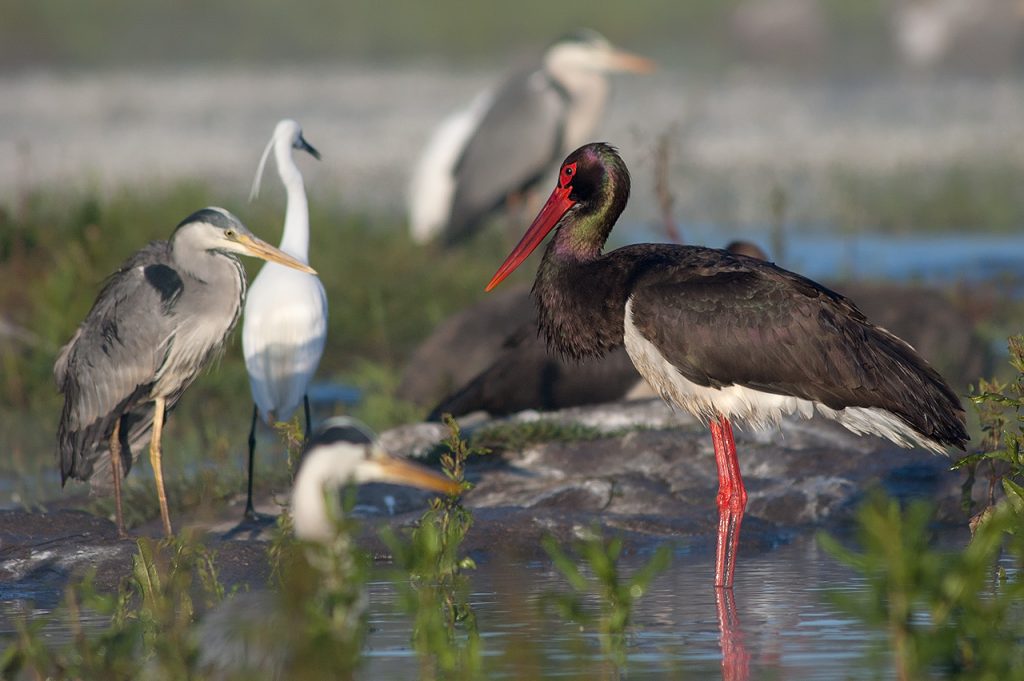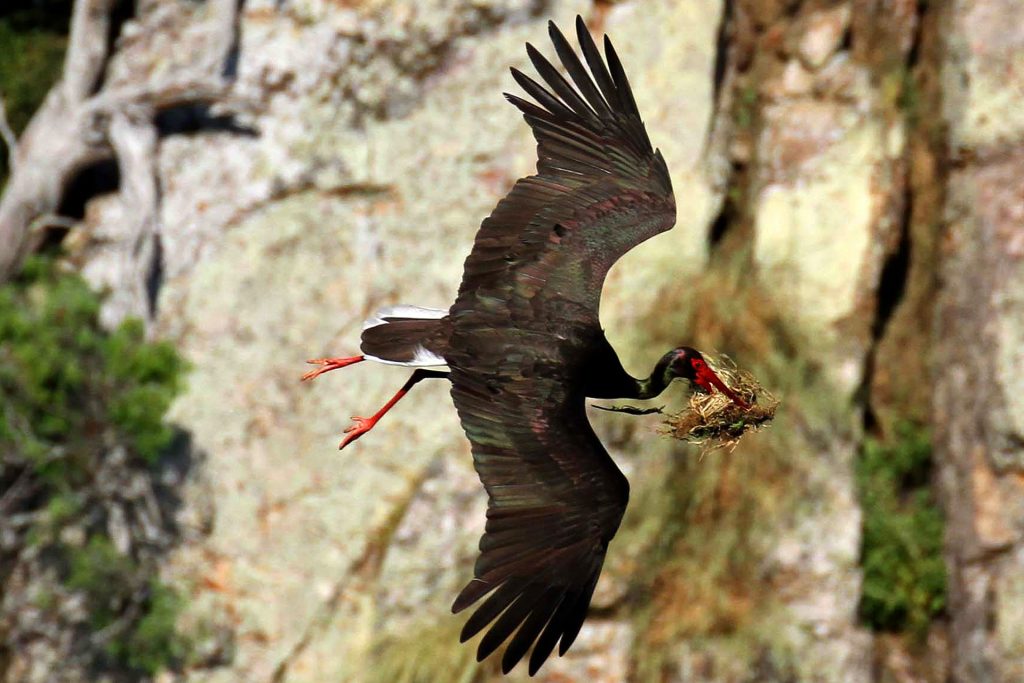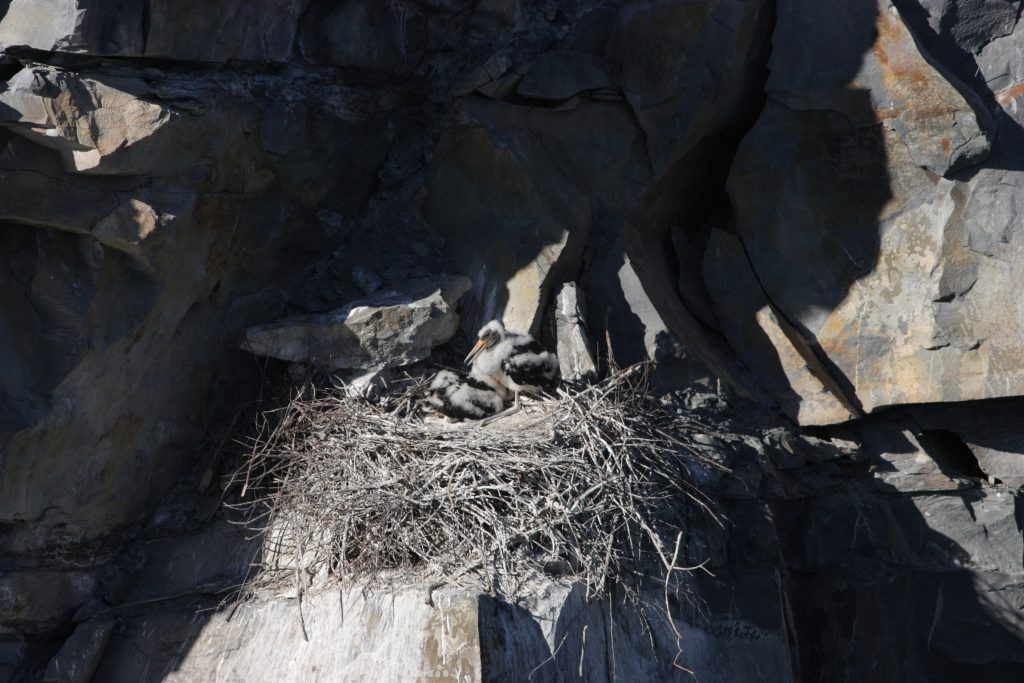BLACK STORK
The Black stork (Ciconia nigra) is a unique large bird in the stork family Ciconiidae.
Black storks have the widest geographical range of any species in the stork family Ciconiidae.
A widespread but uncommon species, they are found throughout the Palearctic, from Portugal to China during the nesting season. It is a long-distance migrant, with European population wintering in tropical Sub-Saharan Africa and Asian population in the Indian subcontinent.
Characteristics
Similar to White storks, Black storks are large birds with sturdy builds, measuring 95 to 100 cm from beak tip to end of tail and weighing around 3 kg. It has a wingspan of 145 to 155 cm.
Adults have long necks, bills, and legs, short tails, and wide wings. They have a black body with varying green and purple gloss on the feathers and white areas on the breast, belly, armpits, axillaries and undertail coverts. They have dark brown irises and bare red skin around its eyes. The bill and legs are scarlet red, intensifying during mating season. In winter months, the bill and legs turn brown. The sexes are identical in appearance, except that males are larger than females on average. The breast feathers are long and shaggy, forming a ruff which is used in some courtship displays.
Upon hatching, the chick is partly covered with short, sparse, whitish down feathers. This early down is replaced about a week later with a denser coat of woolly white down. By three weeks, the young bird acquires black feathers starting with the scapulars and flight feathers. On hatching the chick has pinkish legs, which turn to greyish-black as it ages. Its beak is orange with a brownish tip. By the time it fledges, the juvenile resembles the adult in plumage, but the areas corresponding to the adult black feathers are browner and less glossy, but these colors become vibrant by one year of age. The scapulars, wing and upper tail coverts have pale tips. The legs, bill and bare skin around the eyes are greyish green.
It walks slowly and steadily on the ground and like all storks, in flight it is also a “glider” with their long and broad wings, flying slow with regular wing strokes taking advantage of air thermals and with its neck out-stretched.
Just like the White stork, when migrating between Europe and Africa, it avoids crossing the Mediterranean Sea and detours via the Strait of Gibraltar in the west or the Levant in the east, because the air thermals on which it depends for soaring do not form over water.
Diet
The main food of the Black stork includes all kinds of fish and amphibians but it may also feed on small reptiles, crabs, mammals and birds, and invertebrates such as snails, molluscs, earthworms, and insects like water beetles and their larvae.
Foraging for food takes place mostly in fresh water, like small forest rivers and ditches, though it may look for food on dry land at times. On rarer occasions, it can be seen feeding from lakes, fish ponds, shallow seawater and meadows. Research in recente years indicates that they can fly distances of up to 25 km from the nest to reach good feeding grounds. The Black stork wades patiently and slowly in shallow water, often alone or in a small group if food is plentifull. It has been observed shading the water with its wings while hunting.
The diet of non-breeding birds is similar to that of breeding birds.
Habitat
Black storks inhabits old, undisturbed, open forests which are close to water. They build nests high in trees and forage in shallow streams, pools, marshy wetlands and rivers. It generally avoids large bodies of water and dense forest. They can be found in hilly, mountainous terrain also, as long as there is enough water nearby for foraging.
Less is known about their wintering range, but they are presumably found in wetland areas in which they hunt for food.
Distribution
Black stork was originally widely established breeding throughout the Palearctic. Today it is a widespread but uncommon species across Europe, clustered in the Iberian Peninsula in the west and much of Central Europe to Eastern Asia, but there are some large gaps in the distribution.
It is migratory, wintering in tropical Africa and Asia, although certain populations of Black storks are sedentary or dispersive. An isolated population exists in Southern Africa, where the species is more numerous in the east, in eastern South Africa and Mozambique, and is also found in Zimbabwe, Swaziland, Botswana and less commonly Namibia.
Behaviour
The Black stork is known for their shy and solitary behavior, therefore, it is generally found alone or in pairs and and it tends to stay far from human activity and development.
Being a migratory bird and active during the day they can be seen in flocks of up to a hundred birds when migrating or during winter.
Communication
Though they are loudest of all storks, Black storks are fairly quiet birds. They have a wider range of calls than the White stork with few loud vocalizations, using low grunts, whistles and hisses. Displaying males produce a long series of wheezy raptor-like squealing calls rising in volume and then falling. It rarely indulges in mutual bill-clattering when adults meet at the nest. Adults will do so as part of their mating ritual or when angered. The young clatter their bills when aroused.
The up-down display is used for a number of interactions with other members of the species. Here a stork positions its body horizontally and quickly bobs its head up from down-facing to around 30 degrees above horizontal and back again, while displaying the white segments of its plumage prominently, and this is repeated several times. The display is used as a greeting between birds, and—more vigorously—as a threat display. The species’ solitary nature means that this threat display is rarely witnessed.
Reproduction
The Black stork prefers to construct its nest in forest trees with large canopies where the nest can be built far from the main trunk and generally in places far from human disturbance. Nests are built by mating pairs and are large, solidly constructed platforms made from sticks and twigs, and sometimes also large branches. Males determine where the nest is to be located and collect the sticks, mud, and grass. Females assemble the nest.
Very similar with the White stork each nest measures 1 – 2 m in depth, 0.8 – 1.5 m in diameter and 60 – 250 kg in weight at elevations from 4 to 25 m. Nests may also be used for several years.
Most Black storks once a mate has been found, they are seasonally monogamous, remaining with their mate through the breeding season but not necessarly across years. Pairs in courtship have aerial displays that appear to be unique among the storks but these courtship flights are difficult to see due to the densely forested habitat in which they breed.
The breeding time of the Black stork is between April and May in the Northern hemisphere, with eggs usually laid in late April. In Southern hemisphere, breeding takes place between September and March.
A pair raises a single brood a year and the female typically lays 3 to 5 grey-white eggs per clutch, or rarely even six, which are laid at two day intervals. They typically measure 68 mm x 52 mm. Hatching is asynchronous, and takes place at the end of May. Incubation takes 32 to 38 days, with both sexes sharing duties, which commence after the first or second egg is laid. The first hatchling typically has a competitive edge over the others.
After hatching, at least one adult remains in the nest for two to three weeks after hatching to protect the young. Both parents feed the young by regurgitating onto the floor of the nest.
The chicks fledge after about 2 months, by the end of July, after which they join the adults at their feeding grounds. However, for another two weeks, the young continue to return to the nest, to be fed and to roost at night.
Usually Black stork begin breeding when they are 3 – 5 years old. By this time, the young storks plumage is similar to that of the adults.
Black storks can live more than 30 years.
Conservation Status
The Black stork is classified as “Least Concern” (LC) by the IUCN.
The Black stork population is decreasing, mostly due to deforestation and destruction of habitat. Black storks have also been hunted and during migration, many storks die during collisions with power lines.

